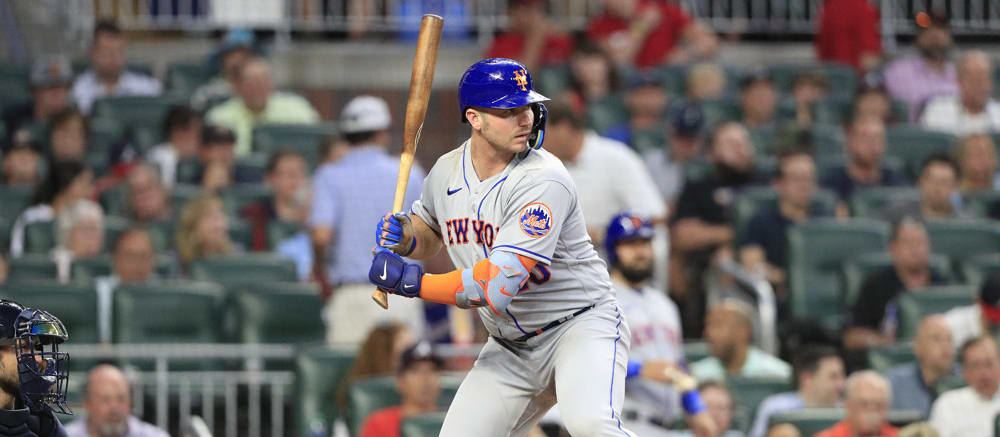I wasn't planning on revisiting this topic at this point of the year, but this particular pull from an interview with Pete Alonso after a game this weekend got my attention:
Pete Alonso was asked about analytics devaluing RBI totals:
"It's a run-scoring competition, it's not a hit competition."
On people who devalue RBIs: "I think they don't necessarily understand baseball." pic.twitter.com/sQAyhMskzd
— SNY (@SNYtv) August 14, 2022
Sure, my playing career ended in my freshman year of college when I realized my barely 80 MPH fastball, weak hitting, and slow speed were better suited for the classroom than the field, so I put all my effort into graduating with my two degrees in Education and have spent my entire professional career in the field. A mindset which was instilled in me throughout my matriculation at the University of Central Florida was to maintain a thirst for knowledge. It is what got me into baseball analytics after I graduated, because I too worshipped the stats on the back of baseball cards well into the nineties. Joe Carter had to be one of the best hitters of the decade because he always drove in a ton of runners. In fact, he drove in at least 98 runs in all but one season between 1986 and 1997, and that one season was one impacted by the strike. Before the 1994 season shut down, Carter was already over 100 RBIs. One rather notable fact during that run is that Carter led the league
I wasn't planning on revisiting this topic at this point of the year, but this particular pull from an interview with Pete Alonso after a game this weekend got my attention:
Pete Alonso was asked about analytics devaluing RBI totals:
"It's a run-scoring competition, it's not a hit competition."
On people who devalue RBIs: "I think they don't necessarily understand baseball." pic.twitter.com/sQAyhMskzd
— SNY (@SNYtv) August 14, 2022
Sure, my playing career ended in my freshman year of college when I realized my barely 80 MPH fastball, weak hitting, and slow speed were better suited for the classroom than the field, so I put all my effort into graduating with my two degrees in Education and have spent my entire professional career in the field. A mindset which was instilled in me throughout my matriculation at the University of Central Florida was to maintain a thirst for knowledge. It is what got me into baseball analytics after I graduated, because I too worshipped the stats on the back of baseball cards well into the nineties. Joe Carter had to be one of the best hitters of the decade because he always drove in a ton of runners. In fact, he drove in at least 98 runs in all but one season between 1986 and 1997, and that one season was one impacted by the strike. Before the 1994 season shut down, Carter was already over 100 RBIs. One rather notable fact during that run is that Carter led the league in RBIs just once, and that was at the start of that streak when he drove in 121 runners for a bad Cleveland team and garnered a 9th place finish in the MVP race.
In this column three months ago, I encouraged readers to familiarize yourself with this leaderboard at Baseball-Reference so you could see which teams and which hitters were doing well with the opportunities presented to them with men on base. It should come as no surprise that the Dodgers are the best team in baseball at plating their runners, as they've plated 15.8 percent of them this season, above the league average of 14.2 percent. What is surprising is the team who is in 5th place:
- Los Angeles: 15.8%
- Atlanta: 15.6%
- St. Louis: 15.5%
- Toronto: 15.1%
- Cincinnati: 15.0%
Four of the five teams on this list are either in first or second place in their respective division, while Cincinnati finds themselves in a battle with Pittsburgh to stay out of last place. Counterpoint one to Mr. Alonso: baseball is as much a run prevention game as it a run-scoring competition. Scoring a bunch of runs does not necessarily guarantee you success.
The Dodgers, while leading all of baseball in scoring runners, are in fact not leading the league in overall baserunners. That honor belongs to the Metropolitans, who are the only team in the league who have had more than 3,000 baserunners this season:
- New York: 3,050
- San Diego: 2,994
- Los Angeles: 2,972
- Colorado: 2,925
- Boston: 2,890
Once again, we find a mixed bag of results here. Seeing Colorado on this list is not surprising given their home park, but what might have been in Boston this year if their offense remained healthy and they had any amount of pitching? They have produced plenty of baserunners but are tied for 8th in baserunners scored (BRS%) with...the New York Mets?
As play begins August 22nd, the Mets find themselves four games up on Atlanta in the NL East, but look at the difference in these two teams when it comes to a run-scoring competition:
TEAM | PA | RUNS | BASERUNNERS | BASERUNNERS SCORED | BRS% |
NYM | 4694 | 590 | 3050 | 452 | 14.8% |
ATL | 4627 | 600 | 2577 | 401 | 15.6% |
Atlanta has squeezed out 10 more runs than New York in nearly identical amounts of plate appearances despite nearly 500 fewer baserunners. This is why many Atlanta fans feel this race is far from over, while New York fans (at least the ones I know) are beginning to get a little nervous.
Getting to the player level, we see that Alonso is currently tied with Aaron Judge for the MLB lead in RBI at 102 as one of only three players to reach the 100 RBI plateau so far this season. Given the adjustments to the baseball as far as production and handling, it's an impressive feat to already be this high before September begins:
- Pete Alonso: 102
- Aaron Judge: 102
- Paul Goldschmidt: 100
- Jose Ramirez: 99
- Francisco Lindor: 84
- Matt Olson: 83
- Trea Turner: 83
- Kyle Tucker: 82
- Nolan Arenado: 81
- C.J. Cron: 80
However, if we take those same names and look at them under the lens of volume and conversion, we see a different story:
PLAYER | PA | BASERUNNERS | BASERUNNERS SCORED | BRS% |
Alonso | 523 | 382 | 72 | 18.9% |
Judge | 521 | 327 | 59 | 17.1% |
Goldschmidt | 497 | 299 | 70 | 23.4% |
Ramirez | 501 | 324 | 78 | 24.1% |
Lindor | 537 | 358 | 66 | 18.4% |
Olson | 540 | 329 | 59 | 17.9% |
Turner | 530 | 339 | 69 | 20.4% |
Tucker | 461 | 291 | 60 | 20.6% |
Arenado | 476 | 323 | 58 | 18.0% |
Cron | 494 | 348 | 58 | 16.7% |
Alonso has been blessed with the highest number of runners on base this season, and his teammate Francisco Lindor is third on that same list. Josh Bell, with all the Juan Soto walks in front of him, prevents the Mets' duo from being first and second on this list. If we look at all hitters with at least 300 plate appearances this season, we find Alonso 22nd in the league in plating baserunners:
| PLAYER | Age | PA | Tm | BR | BRS | BRS% |
| Jose Ramirez | 29 | 501 | CLE | 324 | 78 | 24.1% |
| Paul Goldschmidt | 34 | 497 | STL | 299 | 70 | 23.4% |
| Michael Harris | 21 | 287 | ATL | 147 | 31 | 21.1% |
| Kyle Farmer | 31 | 408 | CIN | 239 | 50 | 20.9% |
| Kyle Tucker | 25 | 461 | HOU | 291 | 60 | 20.6% |
| Trea Turner | 29 | 530 | LAD | 339 | 69 | 20.4% |
| Tyler Naquin | 31 | 253 | CIN/NYM | 152 | 31 | 20.4% |
| Brandon Drury | 29 | 457 | CIN/SDP | 246 | 50 | 20.3% |
| Luis Robert | 24 | 358 | CHW | 230 | 46 | 20.0% |
| Andrew Vaughn | 24 | 410 | CHW | 237 | 47 | 19.8% |
| Josh Naylor | 25 | 342 | CLE | 220 | 43 | 19.6% |
| Rowdy Tellez | 27 | 447 | MIL | 251 | 49 | 19.5% |
| Andres Gimenez | 23 | 400 | CLE | 241 | 47 | 19.5% |
| Travis d'Arnaud | 33 | 313 | ATL | 169 | 33 | 19.5% |
| Freddie Freeman | 32 | 535 | LAD | 324 | 63 | 19.4% |
| Dansby Swanson | 28 | 524 | ATL | 279 | 54 | 19.4% |
| Bryce Harper | 29 | 275 | PHI | 170 | 33 | 19.4% |
| Justin Turner | 37 | 402 | LAD | 276 | 53 | 19.2% |
| Charlie Blackmon | 35 | 474 | COL | 288 | 55 | 19.1% |
| Ty France | 27 | 457 | SEA | 258 | 49 | 19.0% |
| Garrett Cooper | 31 | 368 | MIA | 184 | 35 | 19.0% |
| Pete Alonso | 27 | 523 | NYM | 382 | 72 | 18.9% |
We also see how the Reds were able to make the first list in this article, with three hitters in the top 10 in driving in baserunners, but only one of them still remains with the club, hence their current struggles with offense. It's also worth pointing out how Cleveland has has three hitters in the top 15 in this area despite being just a league-average team in runs per contest. They are the toughest team in the league to strike out and have used that skill to make the most of their limited opportunities as they've vaulted themselves to the top of the AL Central race.
How is this all relevant to fantasy? Baseball is a run-scoring and a run-prevention contest. Fantasy baseball is a contest of mitigating risk, uncovering gems, and looking for underlying skills. Alonso has all the makings of a modern day Joe Carter with what he has accomplished in his career. That said, he is currently on top of the league in RBI production thanks in most part to a heavy volume of opportunities. To his credit, he's doing a better job in driving in a percentage of his runners than he has in any other season of his career, but he's also seeing runners on base more frequently than he ever has, and his overall numbers with runners on base this season are not much different than they were last season, with one notable exception:
SEASON | PA | K% | BA | OBP | SLG |
2021 | 322 | 21% | .270 | .342 | .530 |
2022 | 276 | 14% | .266 | .362 | .555 |
Credit where credit is due: Alonso has greatly improved his contact with runners on base and has now done so for four consecutive seasons, as he's gone from 26.5 percent to 21.2 percent to 20.8 percent and now the current 13.8 percent in 2022. His overall contact rate has improved from 19.9 percent to 19.5 percent, but his improvement with runners on base has certainly been a factor in driving in runs as he's already doubled his sacrifice fly total from last season and has as many productive outs in 2022 as he had in 2020 and 2021 combined.
As we look to forecast Alonso's future path as a run producer, we have to weigh the past even more than the present in figuring him out. He's currently driving in runners 25 percent more frequently than he had in his career prior to this season, and he currently isn't even in the top 20 for plating baserunners. If he were winning the BRS% competition this season as Ramirez is, Alonso would have 122 RBI right now!



































